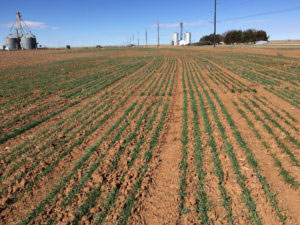Forage barley varieties tested by Texas A&M AgriLife
COLLEGE STATION – Barley may soon be planted to more grazing acres as Texas A&M AgriLife continues to research alternatives for the cattle and dairy industries in Texas.
Barley grain is commonly used in other parts of the U.S. for malting and as a feed source for animals. But Dr. Clark Neely, Texas A&M AgriLife Extension Service state small grains and oilseed specialist in College Station, said it is a suitable forage crop for grazing and silage that offers some advantages over other cool-season forages.
“Forage variety trials around the state indicate barley is very competitive with other small grains for yield potential,” Neely said. “We are currently screening Oregon State University breeding material under several Texas environments to identify the best adapted lines for future co-varietal release.”
He said preliminary findings suggest barley offers greater resistance than wheat to a major pest in Central and South Texas, Hessian fly, which would be a great advantage to growers in these regions. A final stage of the project in 2018 will confirm these findings in a growth chamber setting.

During the initial year of screening in 2014, Neely and his team evaluated 800-plus barley lines. These were reduced to 150 lines based on characteristics such as disease resistance, vernalization requirements and grain production, he said.
During the 2016 and 2017 seasons, Neely’s team planted 116 winter and facultative – can be planted in the winter or spring – barley lines from the Triticeae Coordinated Agricultural Project in replicated plots at College Station, McGregor, Comanche, Brady and Dimmitt to further identify high yielding lines superior to commercially available varieties in Texas for forage production.
Winter barley follows a similar growing season to winter wheat, planting in mid to late fall and harvesting in the spring for forage, though some producers suggest planting barley later than wheat in the fall in the High Plains if grown for silage. The breeding lines being evaluated for fall forage and silage production are winter and facultative types.
The silage trials consisted of 5 feet by 15 feet plots. During the growing season, plot heights and row clippings were taken per plot at the Brady and Dimmitt locations to validate normalized difference vegetation index or NDVI readings taken using the Trimble Greenseeker Handheld Sensor.
“These measurements help us estimate the relative differences in experimental lines for fall forage production,” Neely said.
Ibrahim said the NDVI readings are part of a remote-sensing approach to utilize ground- and aerial-based measurements to evaluate the barley lines for forage potential and reaction to crop stresses and maximize phenotyping efficiency.
The top early season forage and silage producing lines were identified for each environment, Neely said. There were no barley lines ranked in the top five entries at all locations for either forage or silage yield.
“We might find it difficult to select a single line for statewide adaptation or for both grazing and silage,” Neely said, but added these trials will help identify varieties that work best in different regions of the state.
Barley lines at Comanche produced dry matter yields in excess of 6.7 tons per acre and were superior to both wheat and commercial barley varieties, he said, which supports future varietal release.
Neely said the top performing barley lines were entered into the statewide forage trials this year for further evaluation.